Emily Lakdawalla & Bruce Betts • Jun 02, 2010
Phoenix is dead...long live Phoenix!
The latest HiRISE images of the Phoenix polar lander, taken near Mars' northern summer solstice, show why we haven't heard from the spacecraft since it fell silent on November 2, 2008: it appears the solar panels have collapsed. No solar panels means no power; Phoenix is now silent forever.
In a previous post, I showed views of the Phoenix landing site taken during the active mission and also right after the mission ended; in addition, I showed two pictures taken just as spring's first sunlight was arriving at the landing site. Those pictures were very difficult to interpret because of the extremely low angle of the sunlight. Now I have two more pictures to add, taken as spring was giving way to summer; with better lighting, the changes that have come to the landing site are obvious and surprising. To give away the punch line, I'll quote Peter Smith from this week's Planetary Radio interview with Mat Kaplan: the spacecraft parts "are now turned into a Martian red. Mars is taking back the spacecraft."
As a reminder, here's the view from sol 55 of the mission, when Phoenix was still active:
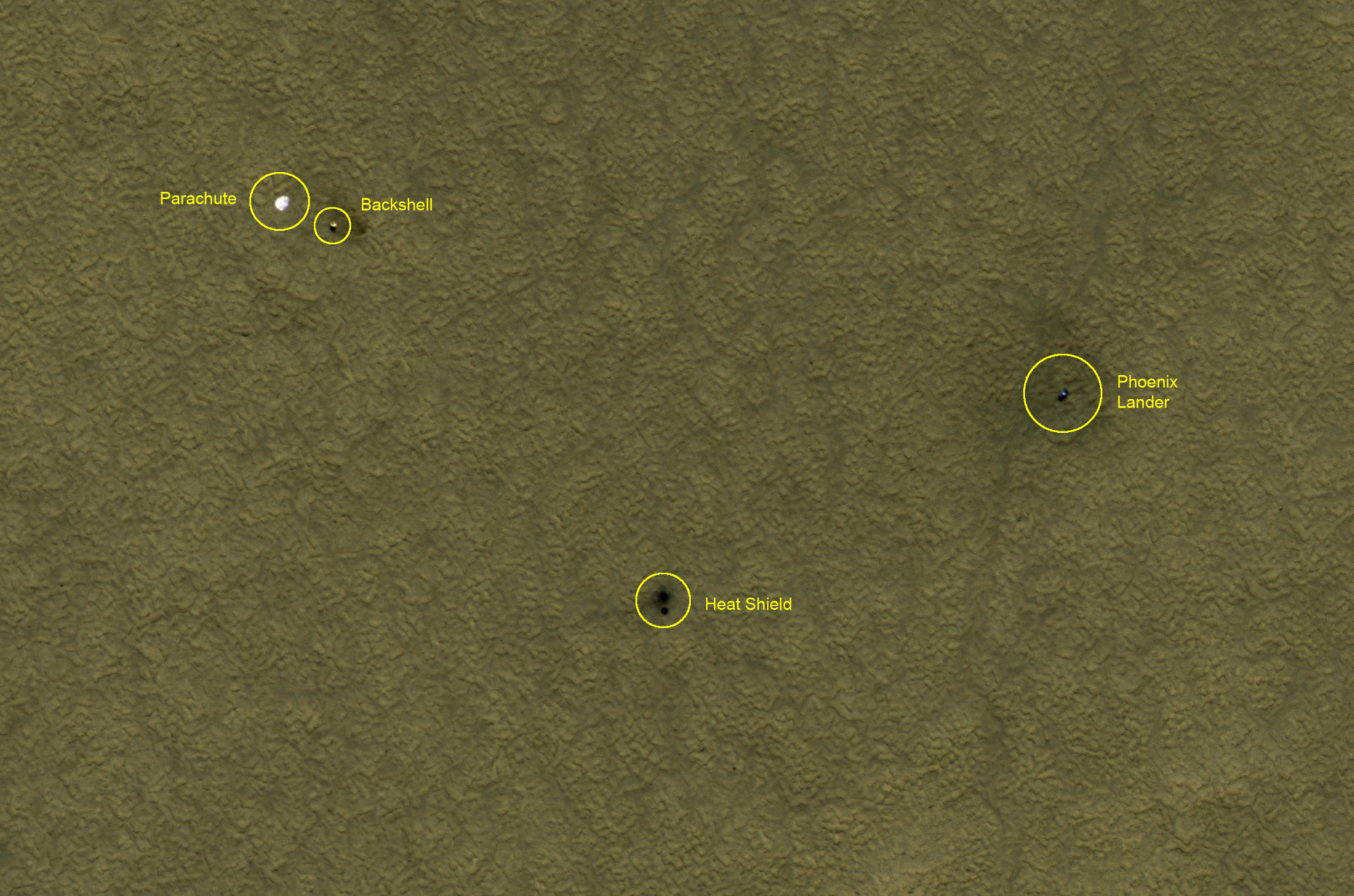
Seen at low resolution, the most obvious features of the lander are the brilliant white parachute and the dark splat of the heat shield, as well as a subtler dark spray left behind by the retrorockets on the lander and backshell. Now look at the same area in January of this year, before the seasonal carbon dioxide frost had completely sublimated away:
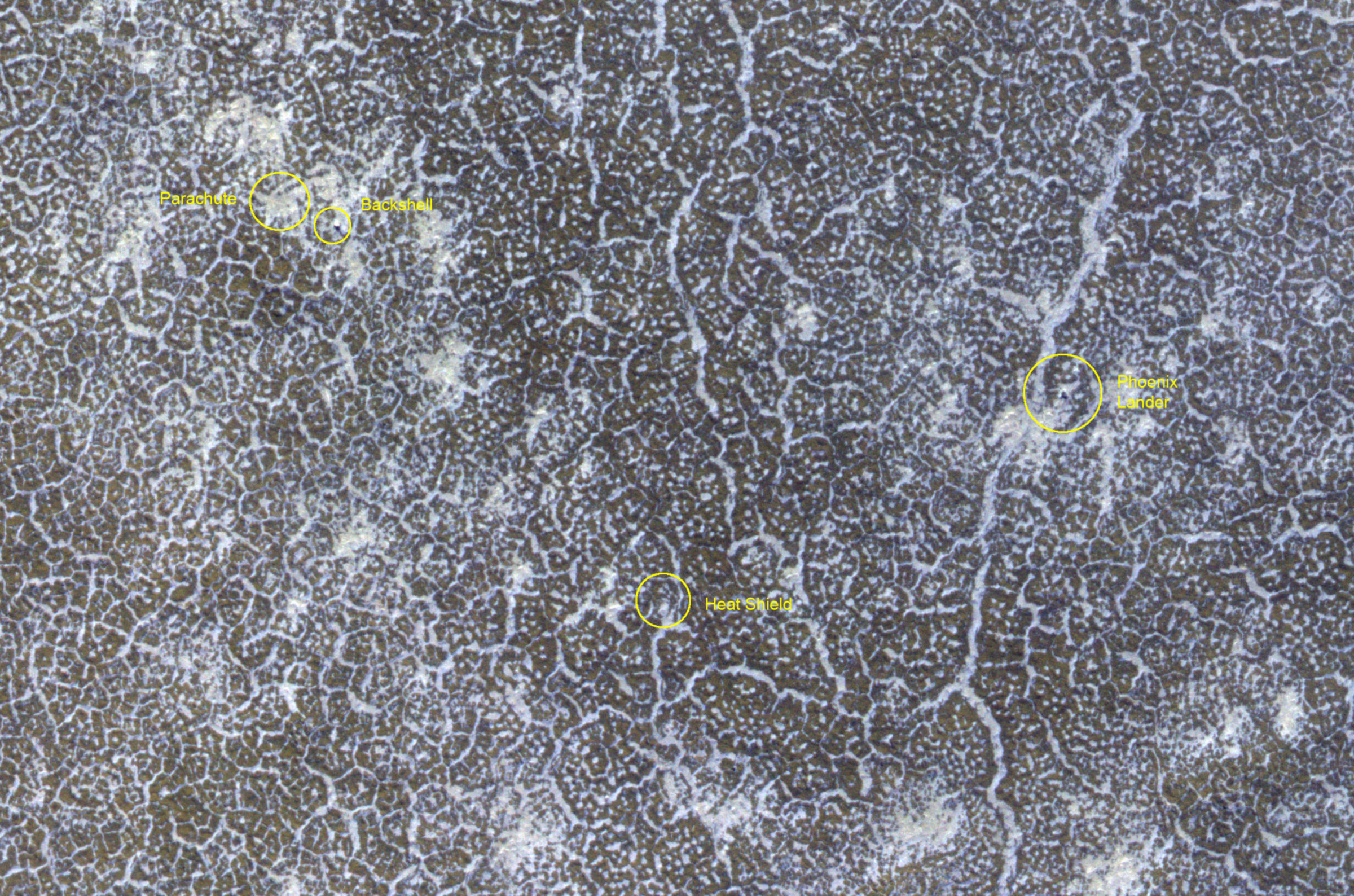
I was only able to locate the spacecraft in this view using the distinctive pattern of the large east-west trough located just to the north of the lander -- that is, I had to know where it was in order to find it. Now look at the same site on May 7, just before the summer solstice:
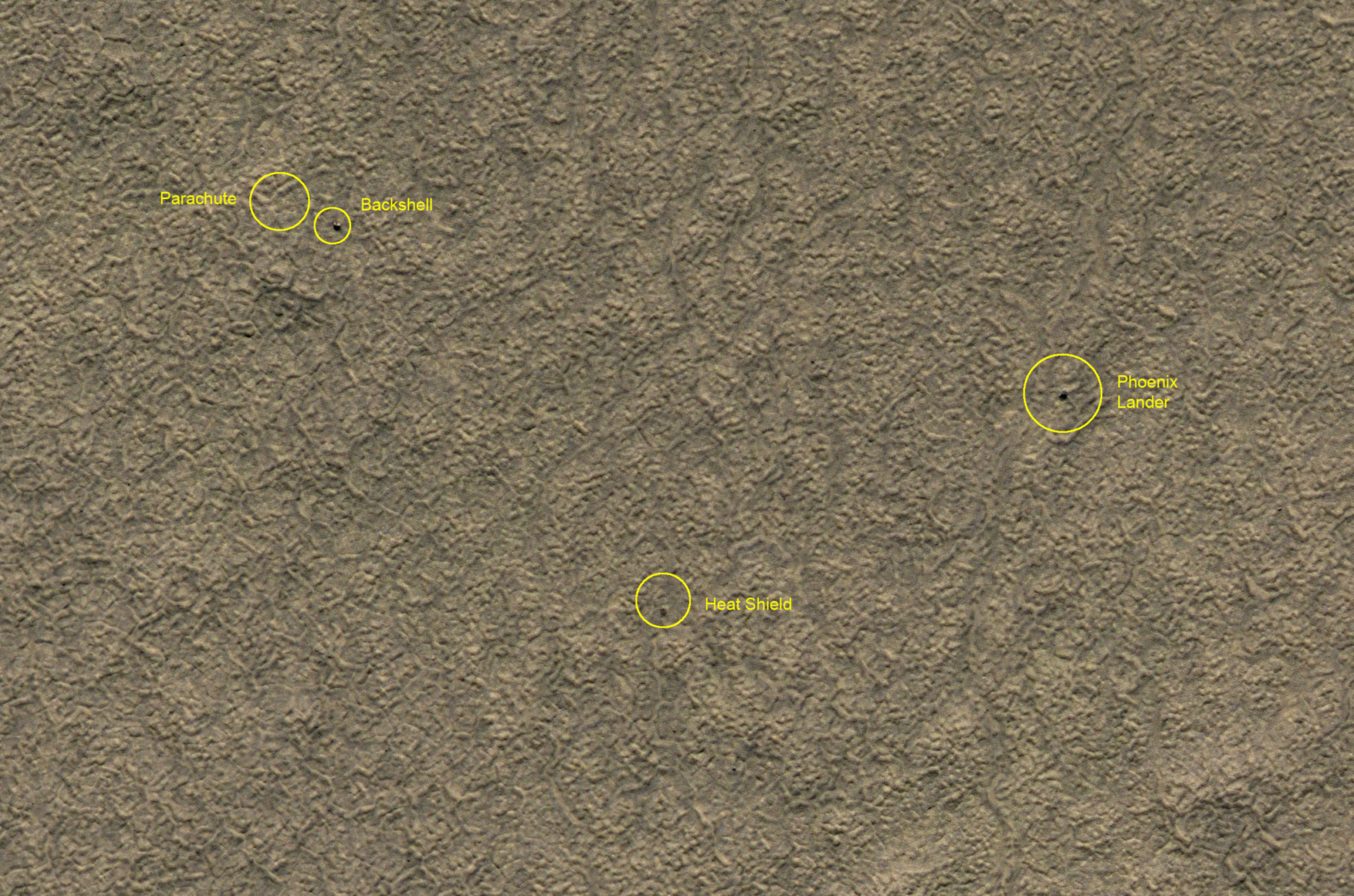
The change from last Mars year is really quite shocking. The parachute and dark backshell splat seem to be totally gone. Now, the most distinctive things about the site seen at low resolution are the shadows thrown by the spacecraft and backshell. While they are not hard to see against the background plains, they are much smaller than the parachute and heat shield splat were, so it was much harder to spot the landing site location at low resolution.
Let's compare the two images taken a Mars year apart at much higher resolution.
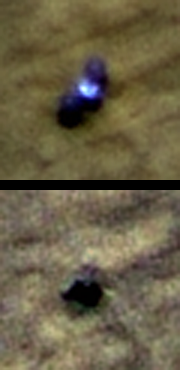
Wow. That's a sobering view. Asked during the radio interview how he felt about seeing what Mars has done to his spacecraft, Peter told Mat "It doesn't feel good at all." Poor Phoenix!
The changes to the heat shield, backshell, and parachute are just as stark. The lesson that Mars enthusiasts should take away from this comparison is that it will be exceedingly difficult indeed to locate the missing Mars Polar Lander, even with the incredible eyesight of HiRISE. Even if Mars Polar Lander's entry, descent, and landing worked almost flawlessly, leaving it fairly intact on the surface with a heat shield, backshell, and parachute nearby, the intervening Martian polar winters may well have acted quickly to hide the spacecraft and its associated hardware from view.

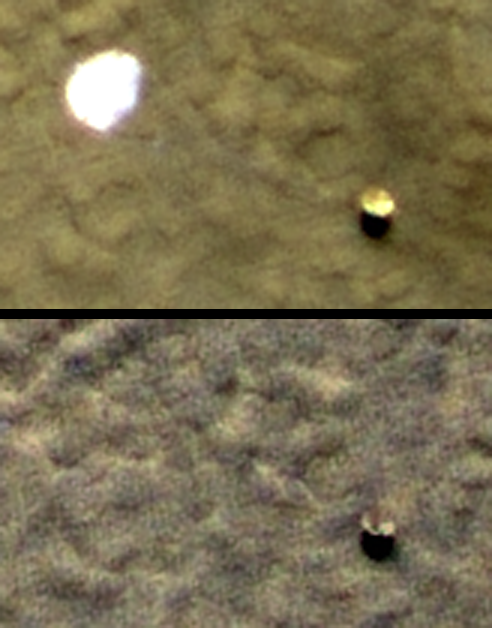
I sent emails to Peter as well as to Mark Lemmon (head of the camera team) expressing my surprise at the rapidity of the changes, and both of them replied. Peter wrote:
The rate of change surprised me also. I would have thought that one year would bring a dusting to the exposed surfaces -- look at the rovers for instance. But to have the solar panels become essentially invisible against the background and the parachute to disappear is a big departure from a slight dusting. One imagines the parachute fluffed by winds and dust devils with some surfaces peeking through the dust mantle. You are right, it has completely returned to Martian red. This leaves little hope for finding MPL [Mars Polar Lander] in the southern polar region.
Mark wrote the following -- if you don't recall what "tau" means, here's an explainer:
I'm a little surprised I cannot make something out even as a texture change. A tau=4.4 dust storm in there would collapse to about a 6 micron thick layer of dust, give or take, and be almost as hard to see through. Remember that one of the most predictable types of dust storms on Mars is the receding-cap storm. As that CO2 goes away, a lot of dust is kicked up locally, and settles back down without going very far.
I'm curious if [the parachute] rotated around the backshell downwind, and maybe a purely textural feature could be found. However, the dust coating is most plausible if it has been immobilized, as it seemed to be during the mission.
So the Phoenix spacecraft really has sent its last data to Earth. But that doesn't mean that Phoenix has finished teaching us about Mars; far from it. Peer-reviewed science results are only beginning to be published from the mission. The things that Phoenix' instruments uncovered -- like the perchlorate salts just below the surface -- are stimulating research into the possibility for Martian life. And Phoenix' experiences -- both the successes and the challenges -- are informing the development of the next Mars mission, the Curiosity rover. Phoenix was the first of the new, low-cost "Scout" line of Mars missions, and it did its job, exploring a previously unexplored landscape, using previously untried methods (untried, at least, on Mars), succeeding at many things, failing at a few, developing valuable lessons to help us move forward in our exploration of the most Earthlike of alien worlds.
Meanwhile, Mars will continue to take back the cold, still piles of metal and glass that is all that remains of the Phoenix spacecraft. One thing that is still there, though probably covered now with a coating of dust, is the Phoenix DVD. Peter wrote to me about that too: "One thing that will remain under the protective dust cover is our DVD of Martian literature. Someday it will be uncovered by a future team of archaeologists. I wonder what they will think of us?"

The Planetary Society's Director of Projects, Bruce Betts, reflected on the end of Phoenix this way:
by Bruce Betts
On the Phoenix spacecraft, a message to the future sits waiting on Mars. Now is a good time to remember that, as NASA has ended operations on the Phoenix mission due to their inability to contact it, and now HiRISE images show likely damage due to winter carbon dioxide ice accumulation.
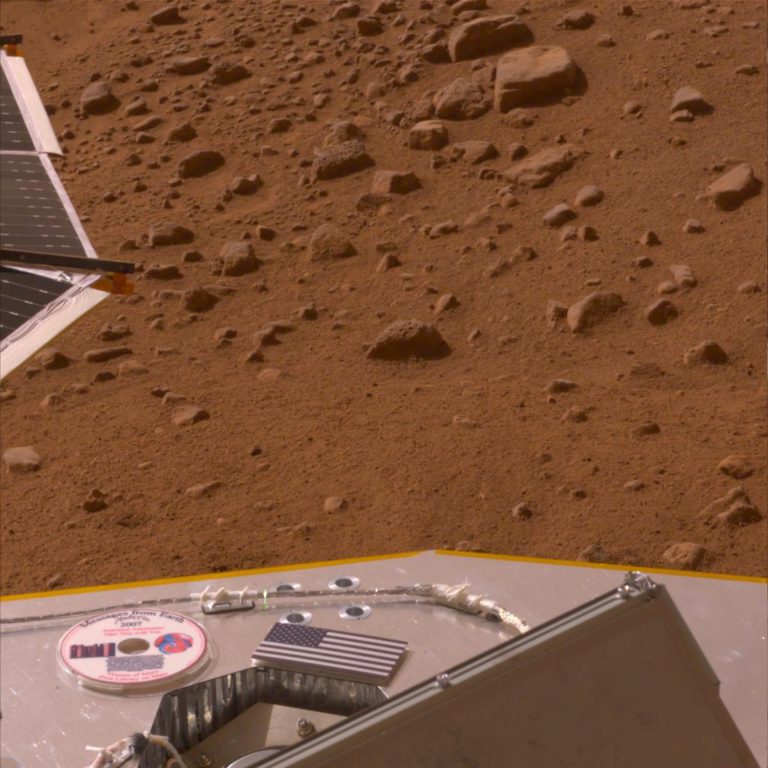
We congratulate the Phoenix team for a hugely successful mission that lasted longer than designed, and returned engineering triumphs and science discoveries. As part of our Messages from Earth program, The Planetary Society provided the Phoenix mission with a silica glass mini-DVD that was attached to the deck of the spacecraft. On that mini-DVD are a quarter million names of those who wanted to send their names to the surface of Mars including all Planetary Society members (if you haven't already, you can print your certificate here). Also, on board is Visions of Mars: the first library on Mars. It includes science fiction and science writing about Mars, Mars art, radio shows including War of the Worlds, and audio-visual greetings from Carl Sagan, Arthur C. Clarke, Louis Friedman, and Judith Merrill, as well as a greeting from Phoenix Principal Investigator Peter Smith.

The DVD's greetings and historical documents are a time capsule, waiting for future explorers to find and decode it. When they do so, they will look back into the past, seeing, hearing, and reading the impressions their ancestors had of Mars. Thanks to the silica mini-DVD technology, provided by Plasmon OMS, the archive should last at least hundreds of years. Even as carbon dioxide ice seems to be collapsing solar panels on the spacecraft, our message to the future sits safely waiting for the future. Thank you, Phoenix!

Here is a roundup of The Planetary Society's coverage of some of the exciting events from this mission. There is also an extensive section about Phoenix, including a sol-by-sol summary of its operational activities.
January 25, 2007, feature story: A Green Valley for Phoenix
July 12, 2007, feature story: Phoenix Prepares for August Launch to Mars' Northern Plains
August 4, 2007, feature story: Phoenix Launches to Mars
August 5, 2007, blog: Phoenix launch wrapup
September 7, 2007, blog: Phoenix returns its first photo
November 15, 2007, blog: No descent images or sounds from Phoenix
May 13, 2008, blog: Landing ellipses
May 24, 2008, blog: Inspired by Phoenix: "Arrival," by Stuart Atkinson
May 25, 2008, blog: Have some courage, NASA!
May 25, 2008, blog: Entry, Descent, and Landing events...
May 25, 2008, blog: First images from Phoenix! - Solar Panel Deployed - Footpads - Color
May 25, 2008, blog: Phoenix: last press briefing of the day after the successful landing
May 25, 2008, feature story:Phoenix Lands Flawlessly on Mars and Sends Home First Postcards
May 26, 2008, blog: OMG!! Parachute!!!! Photo!!!!!
May 26, 2008, blog: Visions of Mars, on Mars
May 27, 2008, blog: The HiRISE parachute image just got even better
May 27, 2008, blog: HiRISE images of the Phoenix landing site
May 28, 2008, blog: A full panorama and an unstowed arm
June 1, 2008, feature story:Holy Cow, Snow Queen! Phoenix Landed on Ice, Team Thinks
June 21, 2008, feature story:Phoenix Scientists Confirm Water-Ice on Mars
June 26, 2008, blog: Phoenix sol 30 update: Alkaline soil, not very salty, "nothing extreme" about it!
June 27, 2008, blog: Strange things under Phoenix
July 10, 2008, blog: More things to see in the amazing HiRISE image of Phoenix' descent
July 17, 2008, blog: Danes on Mars
July 23, 2008, blog: How are we coming on Phoenix mission success?
July 31, 2008, blog: Highlights of the Phoenix sol 64 press conference
August 3, 2008, blog: Apparently there's something more exciting yet to be announced by Phoenix
August 4, 2008, blog: The Phoenix flap
August 6, 2008, feature story:Alien Rumors Quelled as NASA Announces Phoenix Perchlorate Discovery
August 6, 2008, blog: Phoenix perchlorate kerfuffle
August 15, 2008, blog: First image of a speck of Mars dust from the Atomic Force Microscope
September 29, 2008, blog: Phoenix Update, Sol 123: Press briefing with carbonates, clays, and snow!
September 30, 2008, feature story:Phoenix Detects Falling Snow, Digs Up Evidence for Past Water, and Snares Mission Extension
October 28, 2008, blog: The beginning of the end for Phoenix: No more robotic arm operations
October 30, 2008, feature story:Phoenix Enters Safe Mode
October 31, 2008, blog: A brief Phoenix update
November 4, 2008, blog: Phoenix update: Not dead yet; still in "Lazarus mode;" one attempt at microphone use did not work
November 11, 2008, feature story:Sun Sets on Phoenix, NASA Declares End of Mission
November 11, 2008, blog: The end of Phoenix
December 11, 2008, blog: Some interesting information in a Nature story about Phoenix
December 15, 2008, blog: AGU: Some first impressions from today's Phoenix sessions
December 19, 2008, blog: AGU: Wrapping up my notes on Phoenix
March 23, 2009, blog: LPSC, Day 1: Phoenix, morning session
March 25, 2009, blog: LPSC: Saltwater at the Phoenix landing site?
October 28, 2009, blog: HiRISE sees Phoenix in the Martian spring
January 11, 2009, blog: Odyssey's going to start listening for Phoenix
March 2, 2010, blog: LPSC, Day 1: Spirit and Phoenix
April 13, 2010, blog: No signal from Phoenix
Support our core enterprises
Your support powers our mission to explore worlds, find life, and defend Earth. You make all the difference when you make a gift. Give today!
Donate

 Explore Worlds
Explore Worlds Find Life
Find Life Defend Earth
Defend Earth

